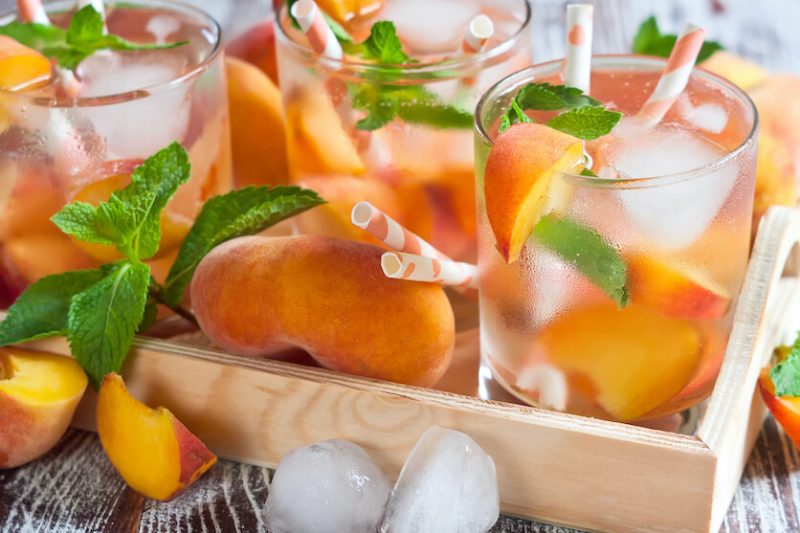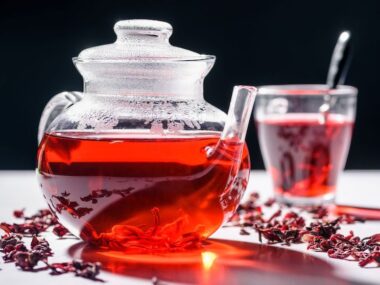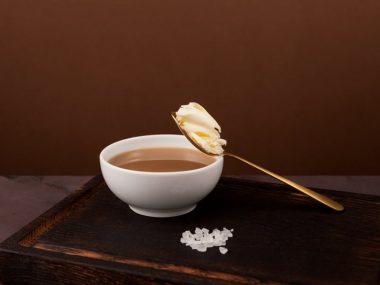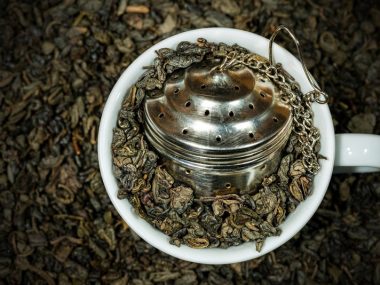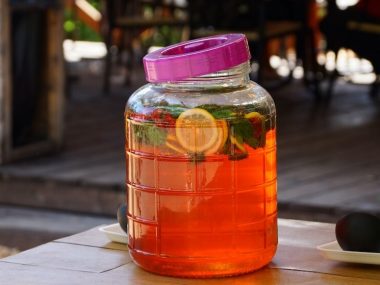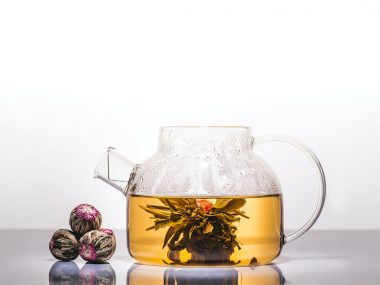One of life’s little treasures is the peach. This juicy gem has found its way into various teas tantalizing our taste buds while curling our toes. Get ready because we are going to “peel back” the fuzzy barrier of the peach and take a journey from the tree to a teacup! Here’s everything you need to know about mouthwatering peach tea!
Table of Contents
What Is Peach Tea?
Peach tea is a beverage made in various ways with different ingredients. It may contain a true tea (black, green, oolong, yellow or white) infused with bits of peaches or peach flavoring, or it may be a tisane (herbal tea). In most cases, peach tea is enjoyed as a hot tea and as an iced tea.
Most of us are familiar with iced peach tea. It’s a summer favorite among tea drinkers all over the world. However, peach tea has broken free from the iced tea stereotype and has assumed a recognized status as an artisanal tea. What makes this tea unique is how it’s enjoyed in various cultures in other countries.
What Is Peach?
A peach (Prunus persica) is one of the most well-known fruits. There’s no mistaking its fuzzy skin and flavorful flesh that surrounds a large pit. One peach in China is most likely not the same as one in the U.S. There is an overwhelming number of different varieties of Prunus persica.
Peaches come in different sizes, shapes, and colors. While the characteristic peach flavor is present in all varieties, some will have a more pronounced sweetness while others are more bitter. The flesh of the peach varies in texture; some will be mushy while others are firm.
Where Did The Peach Come From?
According to “Archaeological Evidence for Peach (Prunus persica) Cultivation and Domestication in China,” Prunus persica (peach) originated in China. Peach stones (pits) were discovered in Zhejiang Province (Yangzi River Valley) in China that date back to 8,000 BP.
The Clemson College of Agriculture, Forestry and Life Sciences Cooperative Extension published an article (Chinese Peaches: Past and Present) back in the 1980s, a 1000-year-old peach tree was discovered by surveyors in Tibet. Peaches in China have a long historical record, but how did the peach make its way around the world? Well, there are claims that the peach may have traveled the Silk Road (ancient trade route.) With time and many courses of exportations, different countries had their own introduction of the peach
Peach Characteristics
To better understand this sweet little gem, let’s look at what makes a peach well a peach. In the world of peaches, there are several ways to classify one of these fruits.
The “Stone” Of A Peach
Peaches are often categorized by how the pit and flesh interact with one another. Have you ever noticed that the flesh of some peaches effortlessly falls away from the pit while others require a knife and patience to separate the pit and the flesh?
Freestone Peach
Freestones are the most “agreeable” peaches because the flesh easily separates from the stone (pit.)
Clingstone Peach
Clingstones are a bit cranky and tend to require a little bit of work to get the stone (pit) and the flesh apart. However, these peaches will have a much sweeter, juicier flesh.
Semi-freestone Peach
This peach is considered a cross (hybrid) between a freestone and clingstone and may be a bit more tart than its counterparts.
The Color Of A Peach

The other way to classify or identify a peach is by the color of its flesh. They will either be yellow or white.
Yellow Peach
Yellow peaches range from pale to deep orange in color and have a reddish tint in and around the flesh closest to the pit. This peach is more commonly consumed in westernized regions of the world. Most of the canned peaches sold in grocery stores are yellow peaches.
White Peach
You’ll find that white peaches are more common in Asian regions.
Different Kinds Of Peach Tea
So, there you have it. The various shapes and colors of peaches. But how does peach make its way into teas? Simply put, tea makers, herbalists, and specialty tea shops harness the essence of peach flavor to make loose-leaf tea, tisanes (herbal teas), and milk/boba teas.
There are many different kinds of teas that contain genuine bits of peach or have an infusion of peach flavoring. The tea may be blended with other true teas. Let’s see what a few of the most common kinds of peach tea there are.
Teas With Peach
Ginger peach tea is a popular one that contains a base of either black, green, white, yellow, or oolong tea. Infusions of bits of ginger or ginger flavoring and peach bits or peach flavoring are added.
Peach iced tea typically starts with a true tea base (black, oolong, green, white, or yellow). Most peach teas used to make hot or iced tea are infused with peach flavoring. A good-quality loose-leaf peach tea may have bits of peach in it along with peach flavoring.
A few other notable peach teas include peach mango green tea, rooibos peach tea, peach honey tea, and a fruity tisane mix of peach, blackberry, and chamomile.
What Does Peach Taste Like?
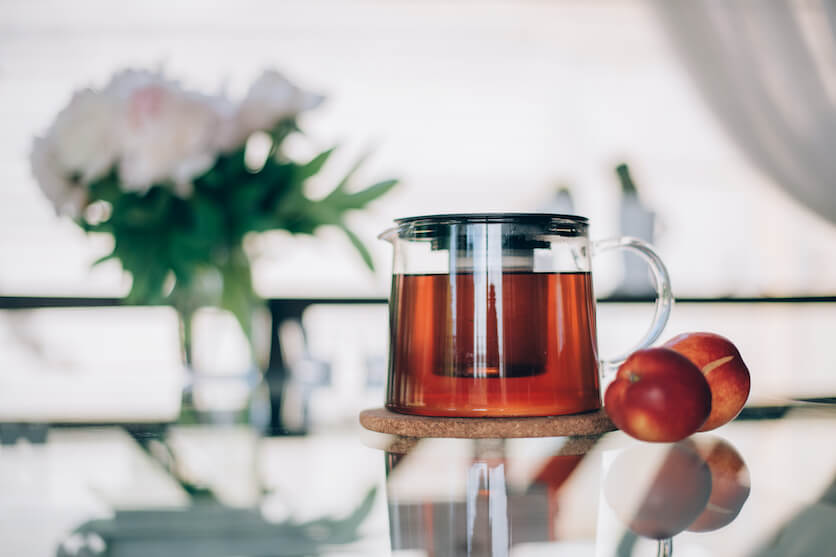
Pinpointing a particular taste of peach is difficult because of the numerous varieties and growing/handling/storage conditions the peach goes through. The sugars, aroma volatiles, and organic acids are the three components that determine how sweet or tart-tasting a peach will be and how good it smells. Most peaches have a tartiness to them and a familiar fruity sweetness. Some peach varieties are sweeter. Post-harvest treatment also influences the flavor compounds in a peach.
Does Hot Peach Tea Have Caffeine?
If the peach tea contains a true tea (black, green, oolong, yellow, or white), it can contain up to 70 mg of caffeine in a six-ounce cup. Peach tisanes (herbal tea) are caffeine-free because they do not have a true tea as one of the ingredients.
Does Peach Tea Have Sugar?
A peach tea with a black, green, oolong, yellow, or white tea base with a flavor infusion will not contain sugar (unless the tea drinker adds sugar.) The same applies to peach tisanes (herbal tea.) If tea is prepared with fresh peaches, it will have the natural sugar from the fresh peach. One medium raw peach can contain as much as 13 grams of sugar.
Peach Tea Benefits
Peach tea made with fresh peach provides a source of Vitamin C, E, K, niacin, folate, iron, choline, potassium, magnesium, phosphorus, manganese, zinc, and copper. Fresh peaches are packed with antioxidants.
Peach tea with a true tea base is typically infused with peach flavoring. In this case, you may not get any added benefit from that flavoring, but you will benefit from the true tea that is in the peach tea. True teas are known to be antioxidant, antimicrobial, antiviral, antifungal, and anti-inflammatory.
True teas that are delicate and mild in flavor, such as white or yellow, marry beautifully with an infusion of peach. Those who prefer tea with a more robust flavor will find that white or yellow tea with peaches is out of this world! Besides, a white or yellow tea provides higher benefits compared to a black tea.
Drink With Caution
The leaves, stems, and bark of a peach tree are poisonous and should never be consumed raw. Some peach teas are made with these parts of the peach tree. When thoroughly cooking such a tea during brewing, the toxins are reduced/removed.
The pit (stone/kernel) of a peach contains cyanogenic glycosides that are very dangerous if ingested. When preparing peach tea with fresh peaches, discard the pit.
How Do You Make Peach Tea From Scratch?
We have a mouth-watering way to enjoy peach tea! Be prepared to have goosebumps when taking the first sip of this tea.
Peaches And Cream Tea Recipe
Ingredients
- ½ cup of heavy whipping cream
- 1 tablespoon of cream cheese
- 2 cups of water
- 1 teaspoon of loose-leaf black peach tea
Directions
Brew the tea:
- Bring the water to a boil.
- Remove from the heat.
- Place the loose-leaf tea into a tea infuser and drop it into the hot water.
- Cover and allow to steep for 5 minutes.
- Remove the cover and the tea infuser.
- Place the tea into the refrigerator to chill for a few hours.
Prepare the cheesy topping:
- Allow the cream cheese to sit at room temperature for 20 minutes.
- Whip the heavy whipping cream until frothy.
- Add the cream cheese to the whipped cream and whip with a wooden spoon.
Finish the tea:
- Pour the cold-brewed tea into a glass.
- Gently spread the cheese topping on top of the tea.
- Enjoy!
Peachy Palates Rule!
Peach tea is the bomb, and if you are like us, peach is something we are very partial to. Drinking peach tea is like having a party in your mouth.
